Top 10 Complete Vegetarian Protein Foods with All the Essential Amino Acids
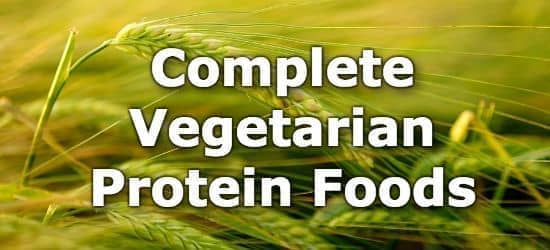
Protein is necessary for the proper growth, development, and repair of all tissues in the human body.
Proteins are made up of amino acids. There are nine amino acids that are considered essential, meaning that you must eat them because your body cannot synthesize them on its own. A protein is considered "complete" if it contains all nine of these amino acids. (1)
Vegetarian foods can be a great source of protein. In general, animal foods contain all nine essential amino acids in relatively high quantities. Plant foods also contain all nine, but they often have lower amounts of particular amino acids. For example, grains contain lower amounts of lysine, while legumes contain lower amounts of methionine and cystine. Because of this, plant foods are sometimes considered to be "incomplete" sources of protein. However, combining multiple different plant foods can give you adequate amounts of all nine essential amino acids. (2) Examples include combining lentils with rice, or hummus with whole wheat bread. Use the complete protein calculator to make sure your foods contain 100% of the recommended daily intake for amino acids.
This list provides the top 10 complete vegetarian protein foods. For the purposes of this list, we assume that "vegetarian" refers to a person who does not eat meat or fish, but does eat dairy and eggs.
Vegetarian foods high in protein include tofu, beans, lentils, yogurt, milk, cheese, green peas, nuts, seeds, whole grains, peanut butter, eggs, and white button mushrooms. The current daily value (DV) for protein is 50 grams per day. (3) This is considered to be a healthy target amount for most people.
However, a specific person's protein needs depend on many factors, including their body size and how physically active they are. The USDA recommends a more specific target of 0.36 grams of protein per pound of body weight per day. Multiply your weight in pounds by 0.36 to get your personalized protein target. If you're an athlete or are very physically active, then you may need more protein than this. You can use this online calculator to provide a personalized estimate of your protein needs.
Below is a list of vegetarian protein foods ranked by common serving size, for more vegetarian protein food ideas see the articles on high protein beans, high protein nuts, and protein rich vegan foods.
Vegetarian Foods High in Protein
-
 1. Firm Tofu + Add
1. Firm Tofu + Add
Protein
per CupProtein
per 100gProtein
per 200 Calories43.5g
(87% DV)17.3g
(35% DV)24g
(48% DV)More Tofu High in Protein
- 20g (40% DV) per cup of medium soft tofu
- 18g (36% DV) per cup of soft tofu
- 34g (67% DV) per cup of tempeh (fermented tofu)
Note: The amount of protein in tofu can range between 4.8g (10% DV) to 17.3g (35% DV) per 100 gram serving (or a little less than 1/2 cup).
See the nutrition comparison of 10 common tofu brands. To find more, use the detailed nutrient ranking of all vegan foods high in protein.
Looking for a brand with this much protein? Try House Foods Tofu.
-
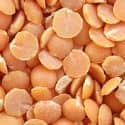 2. Lentils + Add
2. Lentils + Add
Protein
per CupProtein
per 100gProtein
per 200 Calories17.9g
(36% DV)9g
(18% DV)15.6g
(31% DV)More Beans High in Protein
- 17.4g (35% DV) per cup of large white beans
- 16.3g (33% DV) per cup of split peas
- 15.4g (31% DV) per cup of pinto beans
- 15.2g (30% DV) per cup of black beans
- 15g (30% DV) per cup of navy beans
- 14.7g (29% DV) per cup of large lima beans
- 14.5g (29% DV) per cup of chickpeas (garbanzo beans)
See more beans and legumes high in protein.
-
 3. Low-Fat Yogurt + Add
3. Low-Fat Yogurt + Add
Protein
per CupProtein
per 100gProtein
per 200 Calories14g
(28% DV)5.7g
(11% DV)20.5g
(41% DV)- 15g (30% DV) protein per 16oz glass on unsweetned soymilk
- 15g (30% DV) protein per 16oz glass of low-fat milk
-
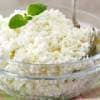 4. Cottage Cheese + Add
4. Cottage Cheese + Add
Protein
per 1/2 CupProtein
per 100gProtein
per 200 Calories11.8g
(24% DV)10.5g
(21% DV)25.8g
(52% DV)Other Cheese High in Protein
- 10.2g (20% DV) per oz of grated parmesan
- 9.3g (19% DV) per 1/2 cup of ricotta
- 9g (18% DV) per oz of non-fat cheddar
See the list of cheese high in protein.
-
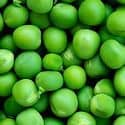 5. Green Peas + Add
5. Green Peas + Add
Protein
per Cup CookedProtein
per 100gProtein
per 200 Calories8.6g
(17% DV)5.4g
(11% DV)12.8g
(26% DV)See more vegetables high in protein.
-
6. Squash and Pumpkin Seeds + Add
Protein
per 1oz HandfulProtein
per 100gProtein
per 200 Calories8.5g
(17% DV)29.8g
(60% DV)10.4g
(21% DV)Other Nuts and Seeds High in Protein
- 6.9g (14% DV) per 1 oz handful of peanuts
- 6g (12% DV) per 1 oz handful of almonds
- 6g (12% DV) per 1 oz handful of pistachios
- 5.5g (11% DV) per oz of sunflower seeds
- 5.2g (10% DV) per oz of flax seeds
- 4.7g (9% DV) per oz (~2 tbsp) of chia seeds
- 4.3g (9% DV) per oz of cashews
-
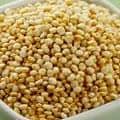 7. Quinoa + Add
7. Quinoa + Add
Protein
per CupProtein
per 100gProtein
per 200 Calories8.1g
(16% DV)4.4g
(9% DV)7.3g
(15% DV)Other Whole Grains High in Protein
- 9.8g (20% DV) per cup of kamut
- 9.8g (20% DV) per cup of teff
- 7g (14% DV) per cup of whole wheat pasta
- 5.9g (12% DV) per cup of oatmeal
- 4.4g (9% DV) per cup of grits
See the list of whole grains high in protein.
-
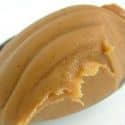 8. Peanut Butter + Add
8. Peanut Butter + Add
Protein
2 TblspProtein
per 100gProtein
per 200 Calories7.7g
(15% DV)24.1g
(48% DV)8.2g
(16% DV) -
 9. Eggs + Add
9. Eggs + Add
Protein
in 1 Large EggProtein
per 100gProtein
per 200 Calories6.3g
(13% DV)12.6g
(25% DV)16.2g
(32% DV)- 1 egg white provides 7% DV
- 1 cup of hard boiled eggs provides 34% DV
-
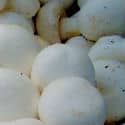 10. Mushrooms + Add
10. Mushrooms + Add
Protein
per Cup CookedProtein
per 100gProtein
per 200 Calories3.9g
(8% DV)3.6g
(7% DV)27.5g
(55% DV)More Mushrooms High in Protein
- 4g (8% DV) per cup of cooked portobello
- 3.5g (7% DV) per cup of cooked shiitake
- 3g (6% DV) per cup of oyster mushrooms
- 2g (4% DV) per cup of morels
- 2g (4% DV) per cup of cremini
- 1.5g (3% DV) per cup of enokis
Note: Cooking reduces the water content of mushrooms, allowing you to eat more mushrooms and more protein per cup.
See the curated list of vegetables high in protein.
Printable One Page Sheet
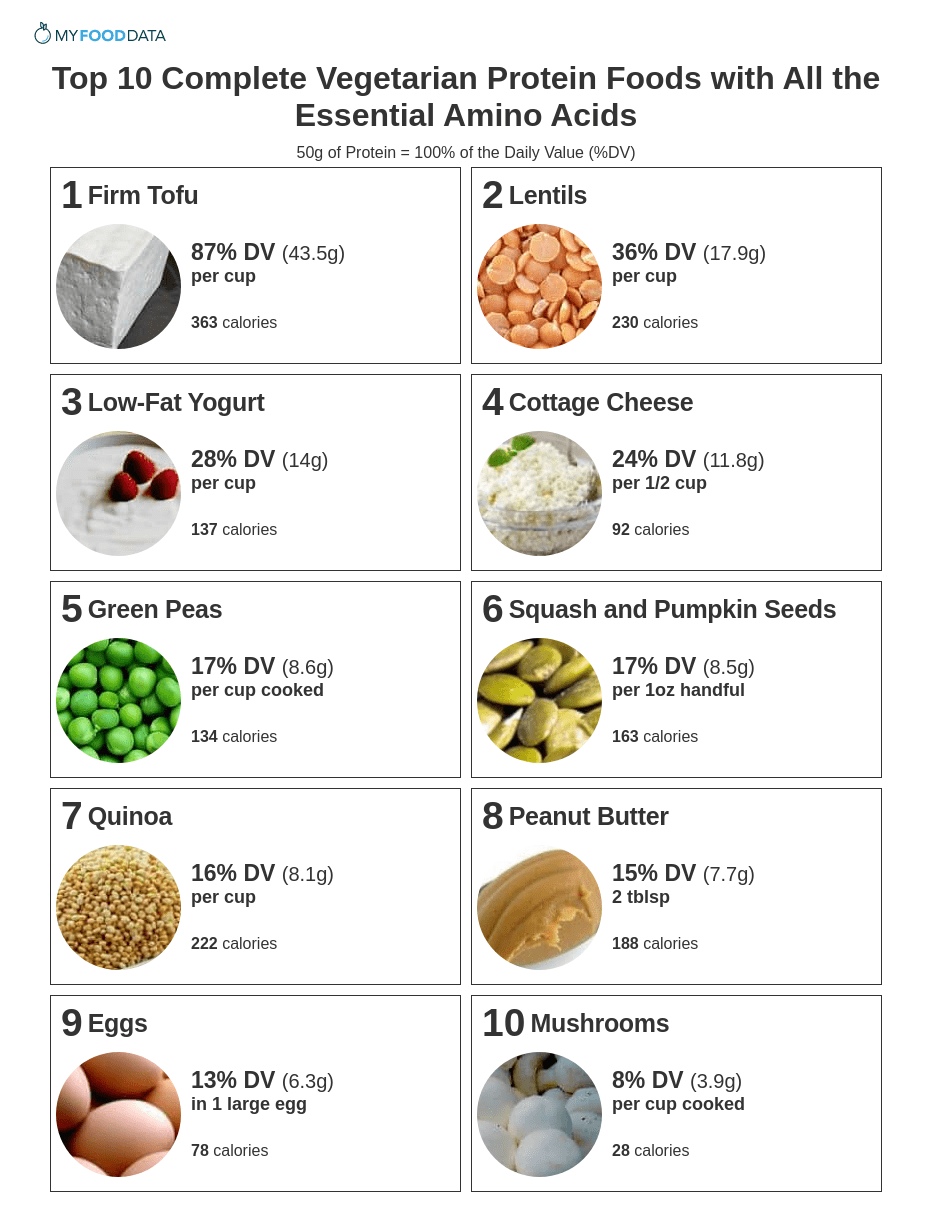
More Complete Protein Rich Foods for Vegetarians
| Food | Serving | Protein |
|---|---|---|
| 1. Soy Protein Isolate + | 100 grams | 177% DV (88.3g) |
| 2. Spirulina + | 100 grams | 115% DV (57.5g) |
| 3. Toasted Wheat Germ + | 100 grams | 58% DV (29.1g) |
| 4. Tempeh + | 100 grams | 41% DV (20.3g) |
| 5. Cocoa Powder + | 100 grams | 39% DV (19.6g) |
| 6. Natto (Fermented Soybeans) + | 100 grams | 39% DV (19.4g) |
| 7. Falafel + | 100 grams | 27% DV (13.3g) |
| 8. Whey Powder + | 100 grams | 26% DV (12.9g) |
From the Nutrient Ranking Tool
Use the ranking tool links below to select foods and create your own food list to share or print.
- Foods High in Protein
- Foods Low in Protein
- Vegetables High in Protein
- Fruits High in Protein
- Vegetarian Foods High in Protein
- Nuts High in Protein
- Grains High in Protein
- Beans High in Protein
- Dairy High in Protein
- Breakfast Cereals High in Protein
- Fast Foods High in Protein
View more nutrients with the nutrient ranking tool, or see ratios with the nutrient ratio tool.
Related
Data Sources and References
- Michael J. Lopez; Shamim S. Biochemistry, Essential Amino Acids. Mohiuddin. National Library of Medicine.
- François Mariotti1 and Christopher D. Gardner. Dietary Protein and Amino Acids in Vegetarian Diets—A Review Nutrients. 2019 Nov; 11(11): 2661.
- U.S.FDA - Daily Value on the New Nutrition and Supplement Facts Labels
- U.S. Agricultural Research Service Food Data Central
Simplify Nutrition Tracking with MyFoodData!
Speedy Tools and Detailed Data FREEEasily analyze your meals to find the best foods for your goals.
✅ Use our recipe nutrition calculator and nutrition comparison tool.
✅ Access expert nutrition data tools and in-depth articles.
✅ Log foods and organize your recipes with a free account.


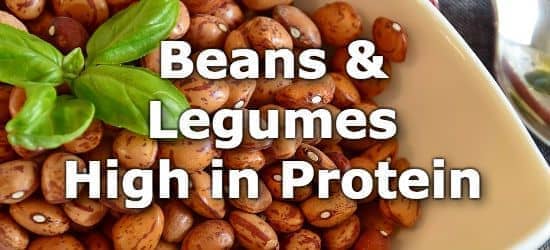 Next ➞
Next ➞
